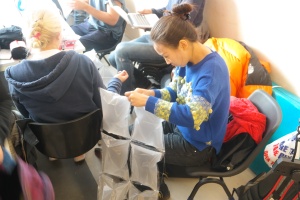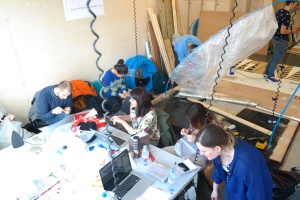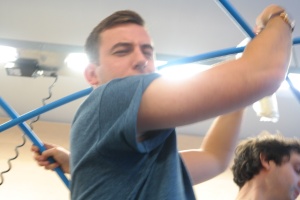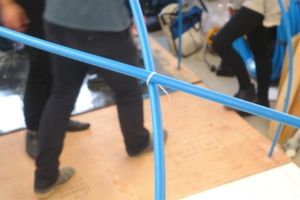Monthly Archives: October 2014
Guide to designing for the tropics
this might be helpful
Updating the Gallery: Documenting the Greenhouse
Internal Construction
Just a sister post to Nicks tights storage solution feature. During the construction of the Greenhouse it occurred to us to define the internal storage with the same system of build as the primary form and start designing the inside as well. 
Think reinforced MDPE pipe and deconstructed Palettes. Just a though…Ideas welcome.
Putting up the Shell.
Previous to Nick and Henrietta’s immense Friday effort applying the skin to the shell of our greenhouse, the video of the collective effort putting up the primary structure.
Find our video here:
Summary:
The Unit 4 Greenhouse taking its next evolutionary step, a collaborative team effort beginning the form the MDPE pipe into strengthened structural arches which in turn will be clad with the Unit 4 patented hand stitched insulate skin and polythene outer skin.
Beautiful.
Available methods of purchase
In order of growth cycle.
Mother culture ;
This is a Petri dish with beings of a spore cultivation. This is predominately used for research purposes and mycologists looking to cultivate from a pure strain. This is the most delicate part of the process and requires incredibly sterile conditions. the agar substrate is used specifically to nurture the growth of bacteria and is very susceptible to air born contaminants
Mother Spawn ;
pure mycelium on a grain mixture, securely produced and packed in breathing Microsacs.This can be used for replication as the substrate has not been colonised entirely by the mycelium. I am currently unsure exactly what process is required in order to replicate the bag but this seems like a viable option for our research.
Cost: Unknown.
Format:
Pack of approx 100 impregnated plug spawn dowels, ready to “plant” into cut logs. These sterilized plug dowels are grooved and fully colonized by pure mushroom mycelium. By using the dowels to inoculate cut logs or stumps, mushroom mycelium can be encouraged to grow throughout or colonize the wood. Once the wood is fully colonized mushrooms will spring forth from cracks or channels in the wood. If you want to keep the dowels before using them, store in a cool dry place. Full instructions are included.
Greenhouse structure timelapse
THE GREENHOUSE | 10/10/14
On Friday myself and Henriette came in to complete the next stages to the greenhouse. We added the inflated A4 laminated thermal quilt the team had created to the underside of the structure. The polythene sheet was then pulled over the structure and clipped into place, using the clips Victoria purchased. This was problematic because the plastic was too thin and kept ripping and skegging on the cable ties and other objects. If the greenhouse is to be housed on the roof, we would need a higher grade of plastic to ensure water tightness.
We then experimented on the structure by adding a perspex window into the lattice grid. Due to the channelled ribs inside the plastic sheet we were able to give the window a curve, enabling it match the contours of the greenhouses form. This turned out successfully, but would be treated differently if the greenhouse was going on the roof because the plastic sheeting would be brought over the window to make sure no water penetrated the skin.
The third thing me and Henreitte experimented with was the internal environment. Following a precedent that both Nate and Conor put forward we were inspired by the Ernesto gallery. An interior that plays with suspension and fabrics in tension.
Using some tights that Victoria provided and some dehydrated coconut husk filled soil I added, we filled the tights up, knotting them in different locations to provide different chambers to grow seeds from. The end result was an interesting organic form that drooped and clung to the structure in a foreign parasitic looking way. The evolution of the greenhouse into a twisting, unregulated growth of pipework and internal stalactites structures appear other worldly and expresses in its appearance it intentions to grow plants and fungi.
Student Research by Zac Mestelle
Ganoderma lucidum, like all fungi is a heterotrophic organism. In most ecological situations, this fungus is seen as a saprophyte. A saprophyte is an organism that feeds on the organic tissue of a dead organism. The fact that they are a valuable saprophyte means that they are valuable decomposer for the recycling of nutrients for the other organisms to use. For G. lucidum, the dead tissue is normally from some sort of tree, which can vary with location.
However, it should be noted that in some cases it is actually a parasite that attacks living trees. A parasite is a symbiotic relationship where one organism benefits at the cost of another organism. This type of relationship can also be seen with theAmerican Mistletoe or theDeer Tick. The hyphae penetrate the tree at an injured or weakened area. Given this opportunity, it can cause the tree great harm.
Like all fungi, G. lucidum digests its food before it ingests it. This means that digestive exoenzymes are released from the tip of the hyphae to break down the organic material. Then, after the material has been broken down into simpler molecules, the hyphal strand ingests the food source. Once absorbed into the hyphae, the food molecules are shipped throughout the rest of the mycelium.
Click here for more
Starting to Build the Greenhouse | 9/10/14
Evening Guys,
Really good stuff today, I personally had a lot of fun just drilling stuff and I felt we made a lot of good progress through our extremely ad-hoc construction method! I thought I would upload a couple of the photos I took as we where finishing up for the day. Just so everyone can see where we got to.
Also as people where starting to drift off home, Nate returned for an another quick chat and suggested the idea of intertwining a couple of the pipes in order to gain additional strength.
We set about constructing a 3 pipe weave held together with, you’ve guessed it, cable ties. We created a 7m long weave however this was a little too long and if pressed into a shorter span it creates quite a strong arch that could be used to add further structural stability to the greenhouse. We unfortunately didn’t have time to drill holes into the base and fix it in place. I have uploaded some photos of the ‘weave’ being constructed to this post as well.
For those coming in tomorrow, good luck continuing with the Greenhouse I am sorry I can’t be there. I am excited to see how it develops further.
Also I know lots of people where taking photos and possibly videos of us constructing the Greenhouse today. It would be great to see them online when people get a chance.
Finally Lauren and I won’t be there tomorrow however we still have the corded drill in the unit space that we didn’t return. Tomorrow afternoon can you please return it to workshop G0-15 in Cassworks.
Reggie



















































You must be logged in to post a comment.